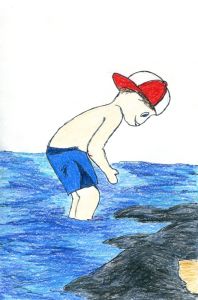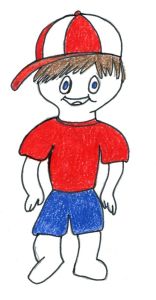Meet Henry – The Sensory Guy
“Hi, my name is Henry and I am one of the Men in the Head ™ who help you do basically everything. I am the one who helps you with your senses, so you can see, hear, smell, taste and touch.
I help your brain let your body know when you are doing each of these things. I let your body know when something is too bright, too loud, too soft, too hot, too cold or just right.
I love seeing, hearing, smlling, tasting and touching- everything!
I love to be outside. I especially like playing in the sand on the beach or rolling down a grassy hill with my friends. I love the winter so I can build snowmen and I love the summer when I get to play in the ocean. I like the way the waves feel on my body and the sand feels in my toes.
 I like to cook. Well… actually I like to eat more! I love all kinds of foods, but my very favorite is spaghetti and meatballs. I like to twirl the spaghetti on my fork and take nice big bites so the sauce gets all over my face.
I like to cook. Well… actually I like to eat more! I love all kinds of foods, but my very favorite is spaghetti and meatballs. I like to twirl the spaghetti on my fork and take nice big bites so the sauce gets all over my face.
I like to listen to music. I also play the harmonica.
I have a new hobby. I love to take pictures or video of everything. I like the way the light glistens in the trees and the dew sparkles on the flowers and the fun sounds of my friends laughing. I want to capture it all!
(Henry’s not very good at his new hobby because he gets lost in the moment and just enjoys the lights, colors and sounds. Sometimes he forgets to turn on the camera or hit record on the video. He doesn’t mind though, he just likes to try.)
My favorite color is ALL OF THEM! I love the way they look together and how they end up when I mix up my paints.
I love animals the very best. I like all animals, but the best are bunny rabbits. They are so soft and cuddly and their whiskers tickle my face when I get really close to them. Larry & Gary just got a puppy named Max and he’s pretty cool too.
Well, I just wanted to introduce myself and let you know that I am here helping you everyday.”
Your Senses in Laymen’s Terms
Your five senses, sight, sound, smell, taste & touch, rely on your nervous system to relay and process information from your brain to your body. When all is working appropriately, your senses let your body know:
| Sense | Too Little | Too Much | Just Right |
| Sight | Too dark | Too bright | Just in the right range |
| Sound | Too quiet | Too loud | Just in the right range |
| Smell | Too subtle | Too stinky | Just in the right range |
| Taste | Too weak | Too strong | Just in the right range |
| Touch | Too soft | Too harsh | Just in the right range |
When all is working appropriately, you still may not be able to see as well in the dark, prefer quieter pastimes or avoid the perfumes sprayers at the mall, but you are in control of your reactions in these cases. Your body is not receiving this information, interpreting it incorrectly, and then sending wild signals to your brain to either avoid or seek out these senses.
When the body sensory receptors and brain signals are not working appropriately, there is little to no control over the person’s reactions. The signals and responses are not organized, so the senses are not processed appropriately.
If the body signals to the brain that the sensory information is too much or too harsh, then the brain tells the body to AVOID sights, sounds, smells, tastes and touches.
If the body signals to the brain that the senses are too little or too weak, then the brain tells the body to SEEK sights, sounds, smells, tastes and touches.
So, what does this look like in children?
In the first instance, you will have a child who will not like bright lights, will avoid any loud situation such as; parades, birthday parties, or enclosed playhouses. He or she will be intolerant of heavy perfumes in shampoo, soaps, and body washes, will not like spicy foods and will want all of the tags cut out of his or her clothing.
He or she may not want to walk bare foot, take baths, go swimming, play in the sandbox, go to the movies, go to the beach, or play with other loud children. There will be many instances where he or she will AVOID rather than participate.
In the second instance, you will have a child who loves bright lights, loud noises, stinky smells and foods, and immerses him or herself in water, sand, mud, anything to the touch. This child cannot get enough of the senses. He or she cannot be involved in anything too bright, too loud, too – anything. He or she has to have constant sensory stimuli.
Remember, these children are not acting differently because they want to; their bodies are avoiding or seeking stimuli based on how their relays and receptors are transmitting, processing and receiving sensory information between the body & the brain.
Note: I am purposefully not including the vestibular, proprioceptive or behavioral impacts of sensory processing disorder (SPD) in this post. I decisively separated these systems from Henry’s oversight to provide clarity and weight to the various issues involved in SPD. I am also purposefully not speaking directly to SPD as that subject is covered in the SPD condition article posted on December 11, 2012.
Some ‘Sciency-Stuff’
I am not going to get too sciency, but I will provide a high-level science-look of the sensory process.
There are 3 main parts to our nervous system that work together: the peripheral nervous system located in our organs and muscles such as the eyes, ears and limbs; the automatic nervous system for heart rate, breathing, digestion and other things we are not consciously doing; and the central nervous system that involves neurons, spinal cord and brain.
The Central Nervous System is largely responsible for sensory processing once the signals are received from the peripheral nervous system. The Central Nervous System is comprised of three parts:
- Neurons – tell us what is happening inside and outside of our body. Sensory and motor neurons connect the brain and spinal cord to the rest of our body. The sensory ones receive signals from our eyes, ears, skin, muscles, joints & organs. Once a signal is received by the neuron, it communicates messages to other neurons through contact points called synapses. These synapses are divided into two types: presynaptic and postsynaptic. The presynaptic neuron is the one that fires off the signal and the postsynaptic is the one that receives it. These firing signals may either activate the receptors of the receiving neuron that is known as excitatory or facilitatory. They may not activate the receiving neuron that is known as inhibitory. Modulation is the process that balances these facilitatory and inhibitory messages.
The speed at which neurons connect is directly related to a substance called myelin that coats part of the neuron to protect it. The more a neuron is used to process signals, the stronger the myelin gets, which in turn, speeds up these connections.
- Spinal Cord – receives all signals from our peripheral nerves and sends them to the brain, once the brain interprets these signals, the spinal cord receives this interpretation and send messages back to the peripheral nerves
- Brain – we will use the simpler triune brain consisting of the reptilian complex or primitive brain, limbic system & cerebrum in this instance, where the reptilian brain is responsible for reflexive and instinctive behavior, the limbic systems involves our emotions and includes the diencephalon (to be explained below) and the cerebrum is the thinking brain and in this case, once it receives signals from the ‘primitive’ brain stem, is responsible for most of our sensory processing.
The brain stem involves four parts:
a) Crossroads – receives sensory messages from skin & muscles in the head & neck and sends information to the cerebrum
b) Switching gate – sensations from the left side of the body cross over the right cerebral hemisphere of the brain and vice versa
c) Clearing House – vestibular sensations processing for, in this case, hearing
d) Regulator – processes our automatic nervous system and communicates with our vestibular system
Diencephalon – part of the limbic system and involves the following areas:
a) Hippocampus – compares old & new stimuli
b) Amygdala – connects olfactory system and the cortex
c) Thalamus – processing all sensory data, except for smell, and passes these sensations to the cerebrum
Cerebrum – two hemispheres & a connective middle:
a) Left – cognitive side that directs analytical, logical and verbal tasks & the right side of our body
b) Right – sensory & intuitive side – directs nonverbal activities & the left side of our body
c) Corpus callosum- connects the two hemispheres
Each hemisphere has cortical lobes that must work together in order to work properly:
a) Occipital Lobes – vision
b) Parietal Lobes – tactile, among others
c) Temporal Lobes – hearing, among others
d) Frontal Lobes – prefrontal – speech, among others
Lying on top of these lobes are the sensory and motor cortexes.
Sensory cortex – receives tactile, among others
The nervous system is amazingly complex and I always find it a miracle that we operate as effectively as we do.




Great article, Kim. My Henry gets a little overloaded at times!!
Mine too – especially around Christmas with all of the crowds & chaos!